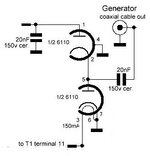neazoi
Advanced Member level 6

What is the voltage drop of this Tek vacuum tube negative output detector, when used on HF?
Should I expect lower voltage drop than germanium diodes, and how much roughly?
Also, what is the maximum input voltage peak to peak that I can apply to the input of this detector?
Should I expect lower voltage drop than germanium diodes, and how much roughly?
Also, what is the maximum input voltage peak to peak that I can apply to the input of this detector?
Attachments
Last edited:


